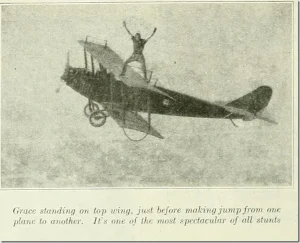Dick Grace
 One of the first fliers to make the attempt to fly to Hawaii was a famous movie stunt pilot, Dick Grace. Grace had performed incredible tricks with his airplane for films, was well regarded and respected. For years he had the desire to make a crossing form Honolulu to the mainland. No attempts were made, however, because the aircraft up to that time were incapable. Now, planes were more efficient, had better speed and could handle a greater fuel load. Grace felt he could do it, and particularly wanted to be successful in the same stretch of water the Navy had been trying to conquer for years, in fulfillment of his dreams.
One of the first fliers to make the attempt to fly to Hawaii was a famous movie stunt pilot, Dick Grace. Grace had performed incredible tricks with his airplane for films, was well regarded and respected. For years he had the desire to make a crossing form Honolulu to the mainland. No attempts were made, however, because the aircraft up to that time were incapable. Now, planes were more efficient, had better speed and could handle a greater fuel load. Grace felt he could do it, and particularly wanted to be successful in the same stretch of water the Navy had been trying to conquer for years, in fulfillment of his dreams.
His search for the right airplane brought him to one designed by a friend, Bill Waterhouse. Lindbergh had had it redesigned for his flight and the original was available. A beautiful parasol-type monoplane, the Cruizair was a two-seater. To accommodate the fuel load he needed, Grace had to have it modified considerably. With the generous backing of Grant E. Dodge, the front compartment was modified to carry between 422 to 435 gallons of gasoline. The engine was a nine cylinder Wright Whirlwind.
The expensive modification completed, Grace had the airplane put on board a freighter for shipment to Honolulu. When it arrived (June 24, 1927), Grace uncrated the Cruizair to find his first setback. Someone had sawed one propelled blade in two. Local military supplies were combed, but no propeller of the same size could be found. His Army friend, Captain Lowell Smith, offered the use of his but it didn’t fit. There was no other choice so he sent for one from the mainland. This was an expensive undertaking, costing his backers $600 in airmail stamps across the continent. In addition, this would take time, and he knew other pilots were vying for the first crossing.
Because Wheeler Field’s runway was too short for the weight of his plane, Grace decided to move his take-off point to the island of Kauai, 75 miles away. There, he chose “Barking Sands” for an assured long run. When the propeller arrived, Grace made tests then, under escort of Navy planes, flew to Kauai without incident.
Making final preparations for the long flight, Grace eagerly awaited good weather. His first scheduled take-off was aborted by 20-30 knot winds. The following morning, the heavy Cruizair found the sandy runway a further detriment to take-off, but eventually managed to roll along at 50 miles per hour. Almost simultaneously, Grace found no rudder control and his tires burst, sending him into a severe ground loop. Experienced in close calls, the stunt flyer saved the plane and himself by careful maneuvering.
The relentless pilot tried twice to get off the next morning, but each time his tires gave out. Feeling certain the heat of the day was a factor in his tire failures, Grace decided on a pre-dawn take-off when the air was cool. This time, the flight had to be successful; no more spare tires were available.
He made it into the air without difficulty. Breathing a sigh of relief, Grace flew easterly when his forward progress was hampered by a tropical rain. The bumpy air currents continued and, at a point perhaps over 200 miles from the take-off point, Kauai, the Cruizair was thrown into violent vibration. Then, suddenly the plane was sent into a steep nose dive. Once again calling on all of his skills, Grace managed to level off at about 50 feet above the water and he headed back for the Garden Island.
The return flight was a series of precarious stalls and dives, but he managed to find his land and bring the airplane in. He crash landed on Kauai. Not equipped with a safety belt, Grace was hurtled out of the cockpit upon impact and traveled a distance of 35 feet. He landed in soft sands, suffering two broken hands only.
Seeing his broken airplane miserably in no condition to carry him to fame as the Pacific’s Lindbergh, Grace’s next thoughts were of “Kauai Leilani,” his three-week old wire-haired terrier who was nearby. He saw an incredible sight. The dog was asleep in his little wicker basket, quite unconcerned. That day the terrier earned a new name, “Dizzy.”
Grace lost all of his assets in that crash, but shrugged his shoulders and went by ship to Wheeler Field on Oahu to greet whoever would be the first in from California.
Excerpted from the book Above the Pacific by Lieutenant Colonel William Joseph Horvat, 1966.
Photo Reference
- Imharnisch. (May 4, 2020) Mary Mallory / Hollywood Heights: Dick Grace, Holywood’s Daredevil Sky Pilot. The Daily Mirror. https://ladailymirror.com/2020/05/04/mary-mallory-hollywood-heights-dick-grace-hollywoods-daredevil-sky-pilot-2/